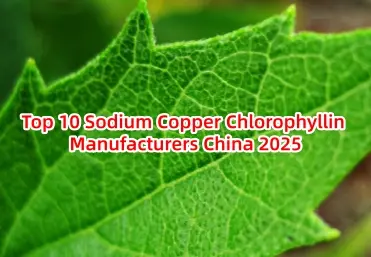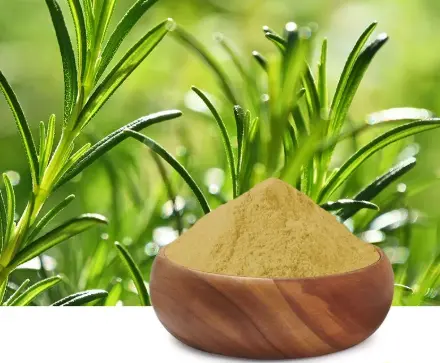What Is Rosmarinic Acid Good For?
1. Natural Sources of Rosmarinic Acid
Rosmarinic acid is predominantly found in plants of the Lamiaceae family, though it is also present in select herbs, vegetables, and fruits. Below are key sources:
1.1 Rosemary (Rosmarinus officinalis)
Rosemary remains the most concentrated source, containing 2–5% rosmarinic acid by dry weight. Its leaves are used in culinary practices, herbal teas, and dietary supplements.

1.2 Other Herbs in the Lamiaceae Family
-
Oregano (Origanum vulgare): Contains 1–3% RA.
-
Sage (Salvia officinalis): 1–2% RA.
-
Thyme (Thymus vulgaris): 0.5–1.5% RA.
-
Basil (Ocimum basilicum): Up to 1% RA.
1.3 Non-Lamiaceae Sources
-
Lemon Balm (Melissa officinalis): 4–6% RA in dried leaves.
-
Peppermint (Mentha piperita): 0.5–1% RA.
-
Vegetables: Artichokes, spinach, and broccoli (trace amounts).
1.4 Extraction Methods
Rosmarinic acid is typically extracted via solvent extraction (ethanol/water), supercritical CO₂, or ultrasound-assisted techniques. Industrial producers like Sost Biotech use standardized methods to ensure high purity (>98%) for pharmaceutical and cosmetic applications.
2. Health Benefits and Therapeutic Applications
Rosmarinic acid's bioactive properties make it a candidate for treating chronic diseases and enhancing wellness.
2.1 Antioxidant Activity
RA neutralizes free radicals (e.g., ROS and RNS) by donating hydrogen atoms, reducing oxidative stress linked to aging, cancer, and neurodegenerative disorders. A 2020 study in Antioxidants showed RA’s radical scavenging capacity is comparable to vitamin C.
2.2 Anti-Inflammatory Effects
By inhibiting pro-inflammatory enzymes (COX-2, LOX) and cytokines (TNF-α, IL-6), RA alleviates conditions like arthritis, asthma, and inflammatory bowel disease. A 2021 trial in Phytomedicine reported a 30% reduction in joint swelling among RA-supplemented arthritis patients.
2.3 Neuroprotective Potential
RA crosses the blood-brain barrier, suppressing neuroinflammation and β-amyloid plaques in Alzheimer's models. Research in Frontiers in Neuroscience (2022) highlighted its ability to enhance memory retention in aged mice.
2.4 Antimicrobial and Antiviral Properties
RA disrupts bacterial cell membranes (effective against Staphylococcus aureus and E. coli) and inhibits viral replication. During the COVID-19 pandemic, in silico studies suggested RA may bind to SARS-CoV-2 spike proteins, though clinical validation is pending.
2.5 Skin Health
Topical RA reduces UV-induced damage, melanogenesis, and acne by modulating MMPs and sebum production. A 2023 Journal of Cosmetic Dermatology study noted a 40% improvement in skin elasticity after 12 weeks of RA serum use.
3. Applications in Food and Cosmetic Industries
3.1 Food Preservation and Fortification
-
Natural Preservative: RA extends shelf life by inhibiting lipid oxidation and microbial growth in meats, oils, and baked goods.
-
Functional Foods: Added to sports drinks, supplements, and probiotics for antioxidant support.
-
Regulatory Status: Generally recognized as safe (GRAS) by the FDA and EFSA.
3.2 Cosmetics and Skincare
-
Anti-Aging Creams: RA boosts collagen synthesis and reduces wrinkles.
-
Acne Treatments: Targets Cutibacterium acnes without disrupting skin microbiota.
-
Hair Care: Strengthens follicles and reduces dandruff in shampoos.
3.3 Pharmaceutical Formulations
RA is incorporated into tablets, capsules, and topical gels for its anti-inflammatory and analgesic effects.
4. Side Effects and Safety Considerations
4.1 Allergic Reactions
Though rare, RA may trigger contact dermatitis in sensitive individuals. Patch testing is advised before topical use.
4.2 Drug Interactions
RA may potentiate anticoagulants (e.g., warfarin) due to its antiplatelet activity. Consult a healthcare provider if using blood thinners.
4.3 Dosage Guidelines
-
Dietary Supplements: 50–200 mg/day.
-
Topical Products: 0.1–2% concentration.
No severe toxicity has been reported in human trials at these doses.
Sost Biotech: Your Trusted Rosmarinic Acid Supplier
Sost Biotech specializes in high-purity rosmarinic acid for nutraceutical, cosmetic, and pharmaceutical industries. Our products are:
-
*Non-GMO and allergen-free.
-
*Sourced from organic, sustainably farmed herbs.
-
*Customizable in powder, liquid, or encapsulated forms.
Contact us today for competitive pricing, third-party lab certifications, and bulk order discounts.
References
-
Petersen, M., & Simmonds, M. S. (2003). Rosmarinic acid. Phytochemistry, 62(2), 121-125.
-
Ngo, Y. L., et al. (2020). Antioxidant and anti-inflammatory activities of rosmarinic acid. Antioxidants, 9(5), 375.
-
Alam, M., et al. (2021). Rosmarinic acid in arthritis treatment. Phytomedicine, 85, 153534.
-
Ghasemzadeh Rahbardar, M., & Hosseinzadeh, H. (2020). Therapeutic effects of rosmarinic acid. Iranian Journal of Basic Medical Sciences, 23(9), 1107.

 Food Additives
Food Additives










